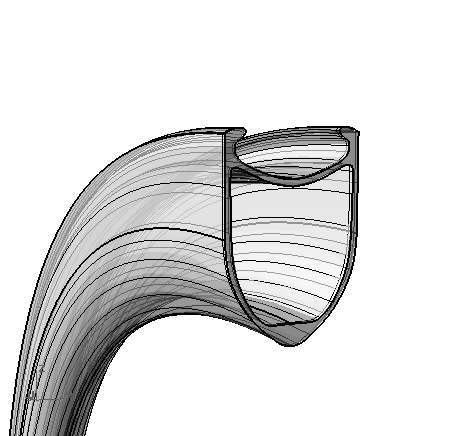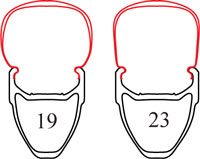|
Home
Your Shopping Cart
|
Carbon Rims
In the last 5 years carbon technology has improved dramatically. To the point where carbon frames are not going to get much lighter or stiffer. For the vast majority of people the best possible way to improve performance is to buy carbon wheels. The deeper rims made possible by the use of carbon equates to more speed and the faster you go the more it means. And nothing, really nothing, improves the look of a bike like adding carbon wheels. All of the riders on the Pro Tour race with carbon wheels. Not some, not most, but all. That's a large percentage. When I first started building carbon wheels about 10 years ago I bought rims from one of the top tier carbon rim makes in the US. To day they were fragile would be a gross understatement. Spoke tensions had to be kept extremely low or the spoke holes would crack, or just as bad, the side walls would cave in. It is rumored that the same wheel company gave a set of carbon wheels to every memeber of a Pro Tour team and at the end of the first day, all the wheels were destroyed. That's a large percentage. But no more. Enve put a top downhill rider on carbon wheels a couple of years ago. That same rider would typically trash alloy rims in a few downhill runs. The carbon wheels lasted the whole season. The quality improvement in the layups of carbon have been so huge it's taken a weakness and turned it into a strength. Most of the braking issues have also been resolved. It once was you were taking your life in your hands descending on carbon wheels. New technologies now add ceramics to the braking surface allowing for higher temperatures without failures. You still need to run carbon specific pads because carbon doesn't dissipate heat like aluminum so the rims get a lot hotter when braking but if carbon are your everyday wheels you don't need to change them.
All of our carbon wheels use wider rims. Some are 23's and some are 25 mm wide. They have the same benefits as the wider alloy rims. Widening the base of the tire does a few things. It straightens out the sidewall so the tire corners better (just like the tires in race cars). It adds more air volume which means you can ride with lower pressures. Lower pressures are preferable because we ride on roads that are not perfectly smooth - if we rode on perfectly smooth roads higher pressure would be preferable. When you hit a bump - either the sidewall will flex (with lower pressure) or the bike will rise (with higher pressure). Inadvertently bouncing the bike with higher pressures increases rolling resistance. And with the benefit of lower pressure comes two more huge benefits. It's much more comfortable because you have better suspension (on a road bike your tires are pretty much all of your suspension) and you have a bigger tire patch. That bigger tire patch means more rubber is on the road and the bike will handle and corner better. So instead of investing in a new bike, the wiser decision is to get better wheels and if performance is important, carbon is the only way to go.
|


